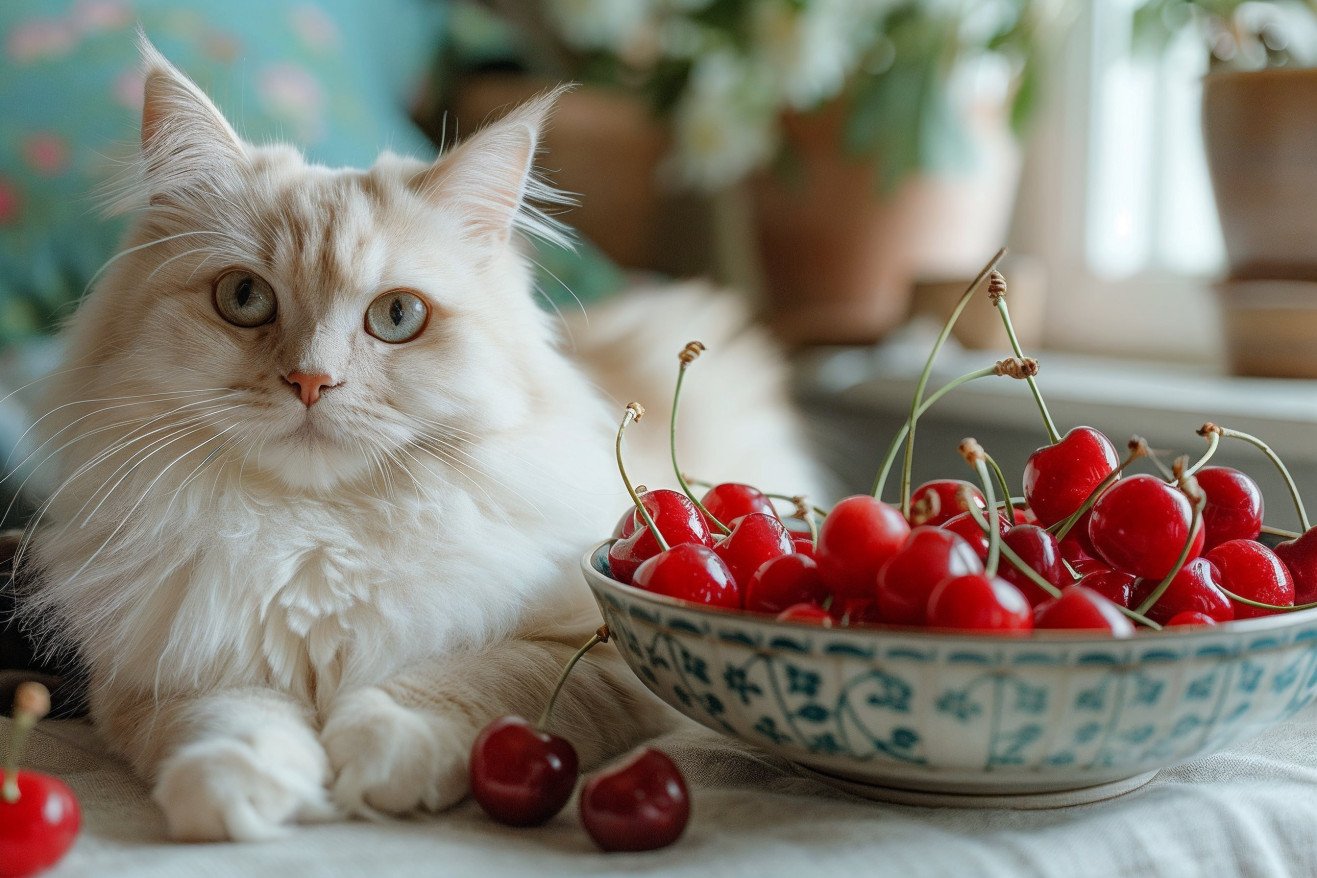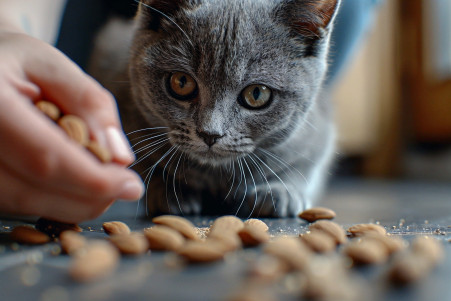Can Cats Eat Cherries? The Dangers Explained
15 February 2024 • Updated 14 February 2024

While cherries are a delicious and healthy snack for humans, can cats enjoy them as well? Cats cannot eat cherries due to the fact that the pits, stems, and leaves contain cyanide, which is poisonous to cats and can result in cyanide poisoning. As a result, it’s best to avoid giving cherries to cats altogether.
This article will explore veterinary science and toxicology research to help you better understand the dangers of cherries for cats. It will also examine research on feline nutrition to explain why certain human foods, including cherries, are not good for cats. By the end, you’ll have a better understanding of what a healthy diet looks like for your cat and how to keep them safe from potentially dangerous foods.
Can cats eat cherries?
How Cherry Toxicity Affects Cats
While cherries may not seem like a threat, they can be dangerous to cats due to the cyanide found in the pits, stems, and leaves of the cherry plant. Cyanide poisoning is a potentially fatal condition that can result from a cat eating any part of a cherry plant, according to Cats.com. Signs of cyanide poisoning in cats include dilated pupils, difficulty breathing, excessive drooling, vomiting, and painful muscle spasms.
If you think your cat has ingested any part of a cherry plant, it is important to get them to a veterinarian right away. The ASPCA notes that symptoms of poisoning can progress quickly and lead to other serious issues, including shock. It is important to act fast to keep the cyanide from causing irreversible damage to your cat’s health.
Cherries are not included in commercial cat food due to the need to meet the nutritional requirements of cats as obligate carnivores and to avoid toxic substances. Fruits like cherries are not species-appropriate, and the risks they pose to cats outweigh any potential benefits they may have in feline diets. By knowing how dangerous cherries can be, cat owners can ensure they are keeping their pets safe from the potential hazards of this fruit.
Understanding the Risks of Cyanide Poisoning in Cats
Cyanide poisoning is fast-acting and life-threatening, as it inhibits cellular respiration and causes systemic hypoxia, or oxygen deficiency, that can damage vital organs within a short period of time.
If a cat is exposed to cyanide, such as by eating cherry pits, it can result in immediate symptoms like respiratory failure and cardiac arrest. The Merck Veterinary Manual explains that cyanide inhibits a key enzyme in the mitochondria, which in turn inhibits cellular energy production and results in rapid cellular asphyxiation.
Long-term exposure to lower doses of cyanide can also result in serious health problems. Chronic cyanide poisoning can interfere with thyroid hormone production, leading to hypothyroidism, and may even cause neuropathy, which impacts the nervous system and can cause symptoms like muscle weakness and ataxia. This condition is diagnosed by measuring cyanide levels in the blood and possibly testing stomach contents or animal feed.
Cyanide poisoning in cats is treated with antidotes like hydroxocobalamin, which binds to cyanide and converts it to a nontoxic compound that’s excreted in the urine. Oxygen therapy is also an important part of supportive care.
The best way to deal with cyanide poisoning is to avoid it altogether. Cat owners should keep their pets away from cherry plants and other potential sources of cyanide to keep them safe. By doing so, cat owners can help protect their pets from the dangers of cyanide and help them stay healthy in general, including by making sure they eat a diet that meets their unique nutritional needs as obligate carnivores.
Cats Are Obligate Carnivores and the Role of Fruit in Their Diet
Cats are obligate carnivores, which means that they need to eat a diet that is primarily made up of meat in order to get the nutrients that they need. VCA Animal Hospitals explains that cats have evolved to require nutrients like certain essential fatty acids, minerals (e.g., calcium), and vitamins (e.g., vitamin A and niacin) that are only found in animal tissue.
Unlike omnivores, cats don’t have the metabolic pathways to efficiently digest plant material, and some plant-based foods can even be toxic to them.
Because of their high sugar content and potential for toxicity (e.g., cherries, which can be toxic to cats due to the cyanide in their pits and stems), it’s generally not recommended to include fruit in a cat’s diet. While some fruits may provide hydration and a little variety, the potential risks often outweigh the potential benefits.
In fact, the ASPCA explains that animal-based proteins are the only source of essential nutrients like taurine, which is essential for a cat’s heart health and vision.
Cats need a variety of amino acids, vitamins, and fatty acids to be healthy, most of which they get from animal protein. As a result, UK Pet Food explains that cats can’t make essential nutrients like taurine, arginine, and arachidonic acid in sufficient quantities and need to get them from their diet.
That’s why it’s so important for cat owners to feed their pets a high-quality commercial cat food that’s been specifically formulated to meet these nutritional requirements.
In short, while humans can eat a varied diet that includes fruit, cat owners should prioritize a diet that reflects their pet’s carnivorous nature in order to ensure that they stay healthy and thrive.
Comparative Toxicity: Other Dangerous Human Foods for Cats
While cherries are toxic to cats due to the cyanide in their pits and stems, they are not the only human food that cats need to be protected from.
Onions, garlic, and other alliums contain thiosulfates that, like cyanide, can cause oxidative damage to red blood cells and result in anemia.
Daily Paws and Preventive Vet list a number of other toxic foods, including chocolate and coffee, which contain methylxanthines that can cause vomiting and seizures in cats. Grapes and raisins have also been linked to acute kidney failure in cats, but the exact toxic substance in them is unknown, as is the cause of the sudden onset of symptoms that is also seen with cherry toxicity.
To keep cats safe from these and other toxic foods, experts recommend a number of common-sense measures, including keeping dangerous foods out of reach and not feeding cats from the table.
Hill’s Pet suggests being especially careful during holidays when cats may be more likely to come into contact with toxic foods.
With a little care and knowledge about the toxic properties of certain human foods, cat owners can make sure that their pets are safe and healthy. And with that knowledge, we can also make sure that we’re feeding our cats in a way that supports their health and well-being.
How to Make the Best Diet for Your Cat
Making sure that your cat has a well-rounded diet is an important part of keeping them healthy. Instead of cherries, which are toxic to cats, consider giving your cat small pieces of cooked meat or cat treats that are made to be safe and tasty for cats.
The importance of a balanced diet cannot be overstated. Cats are obligate carnivores, which means that they need a diet that is high in animal-based proteins, and the life stage of your cat—kitten, adult, or senior—will determine specific nutritional needs.
According to PetMD, feeding your cat food that meets the guidelines set by the Association of American Feed Control Officials (AAFCO) will ensure that it has all the nutrients that it needs in the right amounts.
When you’re looking at cat food labels, make sure that the food has an AAFCO statement of nutritional adequacy that matches your cat’s life stage. In addition, a report by the Countryside Veterinary Clinic notes that water is a nutrient that cats need, and canned foods can be especially helpful in making sure that they get enough of it.
For diets that are tailored to specific health needs, it’s best to work with a vet, who can provide you with the best advice. A vet can help you pick a diet that will help your cat stay healthy and active throughout their life. By paying attention to these factors and talking to a professional, you can make sure that your cat has a diet that works for them.
Final Thoughts: Protecting Your Cat’s Diet
In conclusion, while cherries may be a tempting and delicious treat for humans, they pose a number of risks to our feline friends. The cyanide found in cherry pits, stems, and leaves is especially dangerous, as it can lead to cyanide poisoning, which has a number of symptoms that require immediate medical attention. The bottom line is that cherries are a human food and not something that cats should be eating.
It’s important to know what cats need in their diet. As obligate carnivores, cats need a diet that’s high in animal protein and that doesn’t include certain human foods that can be toxic to them. By learning more about what cats need in their diet, we can avoid accidentally feeding them toxic foods like cherries.
Being a good pet owner means more than just loving and caring for our pets—it also means making sure that we’re taking care of their dietary needs. Knowing what kinds of everyday foods can be dangerous to our pets can help us make sure that we’re feeding them in a way that’s safe.
By taking a mindful approach to our pets’ diets and using the knowledge we’ve gained and the advice of veterinarians, we can make sure that our cats are healthy and happy.


